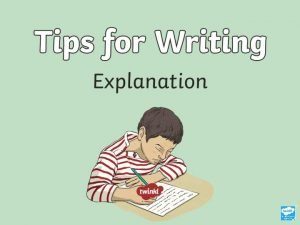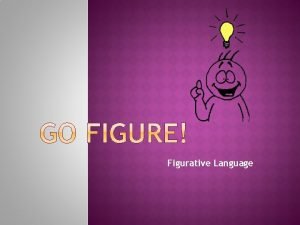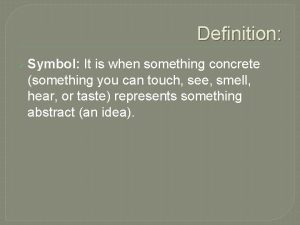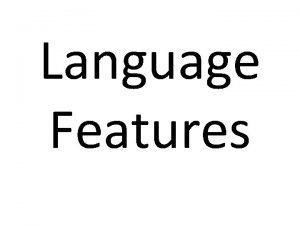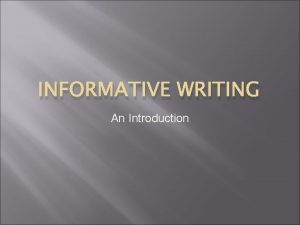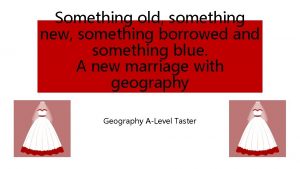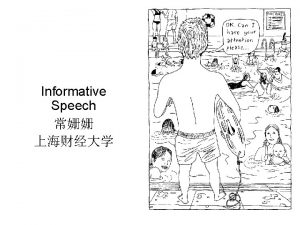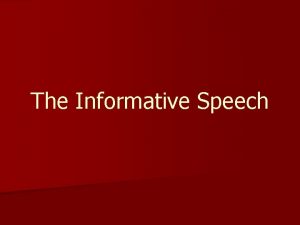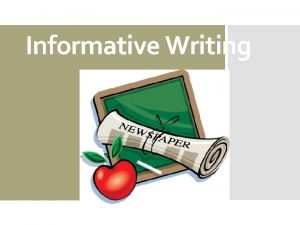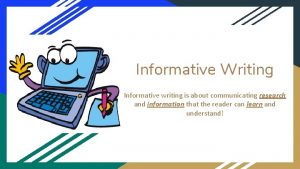INFORMATIVEEXPOSITORY WRITING INFORMATIVE WRITING Informative writing explains something








- Slides: 8

INFORMATIVE/EXPOSITORY WRITING

INFORMATIVE WRITING • Informative writing explains something, tells something, or gives directions. • For example, if you wrote about your favorite aunt, you would be writing an informative/expository essay telling us something about your aunt. Likewise, if you wrote an essay that gave directions for making a paper airplane, you would also be writing an informative/expository essay that gives directions.

ALL GOOD WRITING MUST CONTAIN • Unity: writing that is focused on one topic • Example: You can’t be writing about how cats are the most amazing thing of all time and also be explaining how to breed certain types of dogs. • Transitions: Use words which will help you move smoothly form one idea in your essay to the next idea. • Examples: first, another, most important, for example, on the other hand, etc. • Development: Give information that will make your essay interesting and fun to read. • Anecdotes: little short stories that create a picture in our minds when we read your essay. If you just said your favorite aunt was interesting without telling us about her, your paper would not be developed • Vivid detail and description

BEFORE YOU BEGIN, YOU MUST KNOW… • Topic—What you are going to write about • Direction—Which way you are going to write about your topic. • Three ideas, points, or reasons you are going to write about your subject • You will put these three things together in one sentence called your thesis sentence.

WHAT MAKES GOOD WRITING BETTER • Purpose: Follows prompt completely • Content: Develops your subject well • Audience: Appeals to your audience • Structure: Has logical progression and good closure • Thesis Sentence: Gives essay definite plan and strategy • Paragraphs: Do not contain unrelated sentences • Unity: Presents ideas that flow smoothly (called transition) • Show proficient command of grammar usage and mechanics • Varies Sentence structure to make writing more interesting

INFORMATIONAL TEXT FEATURES • Diagrams: help the reader understand a more detailed or simplified view of information. • Graphs/Charts/Tables: • Organize large amounts of information in a small space. • Helps the reader understand relationships among and between information. • Summarize and compare information. • Maps: Helps the reader understand where an event happens or how far away an event took place. • Timeline: Helps the reader understand important events in chronological order or time order and understand the order of events and how one event may have lead to another • Illustrations: . Helps the reader understand information in a visual way, understand the story, and understand an idea from the text that was unclear.

ORGANIZATIONAL AIDS • Bold print: signals that the word is important • Italics: Helps the reader understand that the word is important. • Titles: Identify the topic of the text, the main idea of the text. Also allows the reader to make connections between what you already know and the text. • Headings: Identify topics throughout the book/article. Divides the text into sections. • Subheadings: Allows for navigation through sections of text. Shows the main idea of each section of the text. • Captions: Help the reader understand what is shown in a photo or illustration or understand information that may or may not be in the text.

WHEN WRITING INFORMATION, YOU MUST CITE! • Whenever you include information that you researched, you must explain where you got the information from. • Whenever you cite or paraphrase information, you must put a citation after the information. • EXAMPLE: “Cats have fascinated people for thousands of years; they have been linked with magic and luck throughout history. ” (All About Cats) • At the end of your essay, you’ll need to include a Works Cited page • "All About Cats. " Cats For Kids. Reg Charity, n. d. Web. 4 Apr. 2017. <http: //www. cats. org. uk/cats-for-kids/about-cats>.
 Explanation purpose
Explanation purpose Explain how something works
Explain how something works Something concrete that stands for something abstract.
Something concrete that stands for something abstract. Smart is something you become not something you are
Smart is something you become not something you are The room is an oven figurative language
The room is an oven figurative language Theme vs topic
Theme vs topic When something represents something else
When something represents something else Something old something new poem
Something old something new poem Adjective language feature
Adjective language feature
